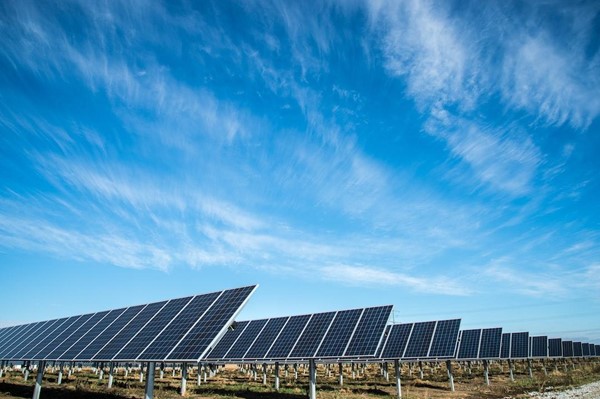Solar Energy and the Power Grid: The Need for Energy Storage and Software Innovation
The Rise in Solar Energy
The development and advantages of solar energy are indisputable. With over 400GW in capacity installed worldwide according to the Global Renewable Energy Status Report 2018, the deployment of solar power plants seems unstoppable.
Technical experience in the design of solar projects encourages developers to carry on utility-scale projects under solar power while at the same time the reduced carbon footprint of these power plants makes them more attractive for governmental organisations
Moreover, according to the latest Lazard´s report, the levelised cost of energy of utility-scale PV plants is as low as $40/MWh, lower than coal ($60/MWh), nuclear ($112/MWh) or gas peaking ($152/MWh).
Due to these technical, economic and environmental reasons, project developers consider solar power as a valuable resource that can be offered to serve commercial or utility-scale power projects by using simulation software like PVsyst, SAM, or PVcase, to show the energy results and economics of these projects.
The Challenge of Large-Scale Solar Power
However, as solar PV plants spread across the power grids, new challenges arise for Independent System Operators (ISOs) who balance the electricity flows.
The power grid is controlled by government or private organisms called ISOs which establish the power flows across the transmission lines according to energy demands and energy generation. Every second, the power grid must be balanced between demand, generation, and energy losses to avoid stability issues and control voltage in busbars across the grid.
ISOs need to accurately predict energy demands with weekly, daily and even 15 minute time frames. This can be done by forecasting energy demands based on historical records of variations according to seasons and daily changes.
This mathematical forecast is later used by grid operators to estimate the power generation plants that need to be connected to supply these energy demands. Grid operators establish spinning reserves and off-line generators to act quickly to balance the power grid among other mechanisms.
Solar power plants are inherently more unstable and uncertain than traditional thermal generation plants. Controllability of these renewable energy power plants is lower as energy production depends on environmental factors (available solar radiation) which cannot be accurately predicted.
Due to this variability and due to government policies that establish a preference for renewable energy sources over carbon-based power plants, every MWh generated from large scale PV plants needs to be injected into the grid.
When a large section of the power grid depends on a variable source of energy, large uncertainties in generation availability appear in the scenario, making it harder for grid operators to keep stability values in the power grid.
The Duck Curve
Solar generation follows a Gaussian shape curve that has its peak value at midday and that rapidly starts early in morning hours while finishing rapidly in later-afternoon hours.
The integration of this generation pattern in the power grid, changes the demand curve, following a duck shape graph as it can be seen below
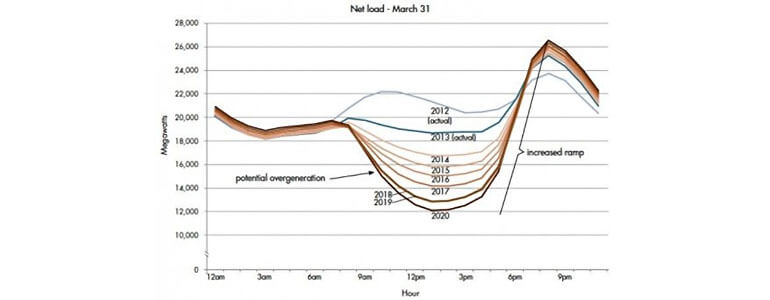
Energy Demand Curve of California Power Grid with Increased Solar Power Generation. Source: US Department of Energy
Midday demand reduces drastically while early morning demand values do not. Moreover, solar energy generation ends during late afternoon hours, precisely when demand tends to increase in the power grid.
This creates a problem in which other energy sources need to rapidly ramp up power production to follow the demand curve which is generally met by thermal or nuclear sources. Moreover, if these power plants are off-line reserves and need to be rapidly turned on to supply incoming energy demands, then the cost to run the power plant increases radically, representing a non-optimise and deeply contaminating solution.
The Need for Energy Storage
Countries with a high PV penetration in the power grid such as Australia are already facing these problems.
If the excess solar energy generated during the midday is not curtailed by grid operators, then the duck curve problem appears in the scenario. In other words, ISOs need to curtail excess solar energy during midday which means that large-scale PV energy is being wasted.
To solve this problem, the excess solar power generation needs to be shifted to be consumed at night, and the only way to do that is by storing it in a large-scale energy storage facility.
The South Australian government also came out with another solution. Promoting distributed small-scale energy storage devices in households and commercial buildings to reduce the amount of excess solar energy during midday. This proposal also increases self-consumption which reduces energy demands.
Large-scale energy storage solutions also serve for other applications in the power grid which makes them considerable options for solar power plant developers. These devices are perfect to apply for the ancillary services market where the following functions can be provided by large scale energy storage plants:
- Frequency regulation
- Voltage support
- Renewable energies stability support
- Demand curve following
- Reserve capacity
- Self-consumption increase
- Power quality increase
- Demand charge reduction
Software Applications for Solar and Energy Storage Solutions
This new migration to energy storage integration in the power grid must also be considered when you are developing large-scale solar proposals. It may be a requirement of the project or you may also propose the option to increase the reliability and the benefits of the project for the power grid.
As a project developer, you will need software applications that help you obtain accurate results in power, energy, and bill of materials to present your PV design. Currently, there are many software applications available, however, you will find these ones very helpful for your utility-scale designs:
- PVcase: Designed to develop the landscape and layout of the solar PV plant by using topographical terrain data to make 3D models of your solar proposal.
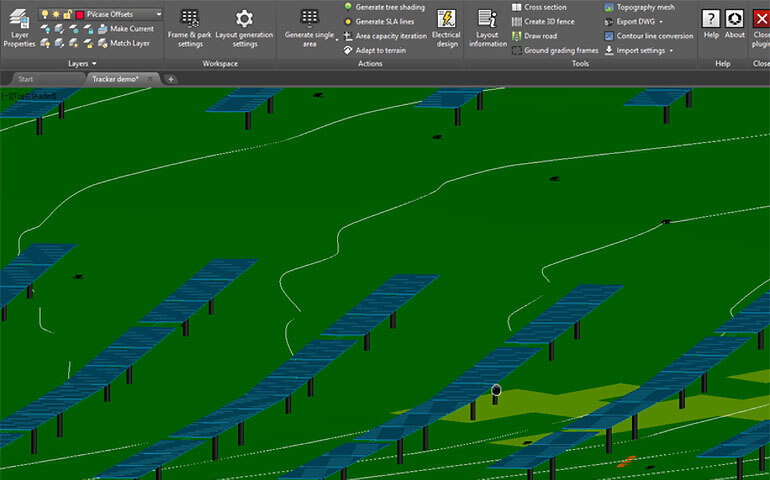
Source: PVCase.com
- PVsyst: Performs energy yield analysis of the PV power plant using meteorological data from NREL, NASA or Meteonorm. Stand-alone and grid-connected with battery backup systems can now be modeled in the latest versions of the software considering self-consumption, peak shading, and weak grid islanding mode operations.
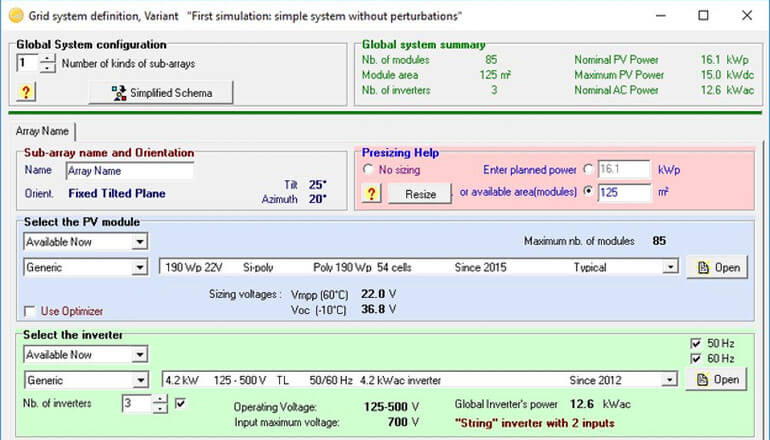
Source: PVsyst.com/features
- SAM: Performs detailed energy yields and economic analysis of adding energy storage devices to your solar PV design.
- Homer Grid: Intended to simulate the addition of renewable energies in a micro-grid model to understand how different sources of energy such as solar, wind, thermal and battery storage interact together to cover power demands. Homer Grid allows solar engineers to design commercial-scale solar with energy storage systems evaluating demand charge reduction, energy arbitrage, self-consumption and modeling complex tariff mechanisms such as Time of Use.
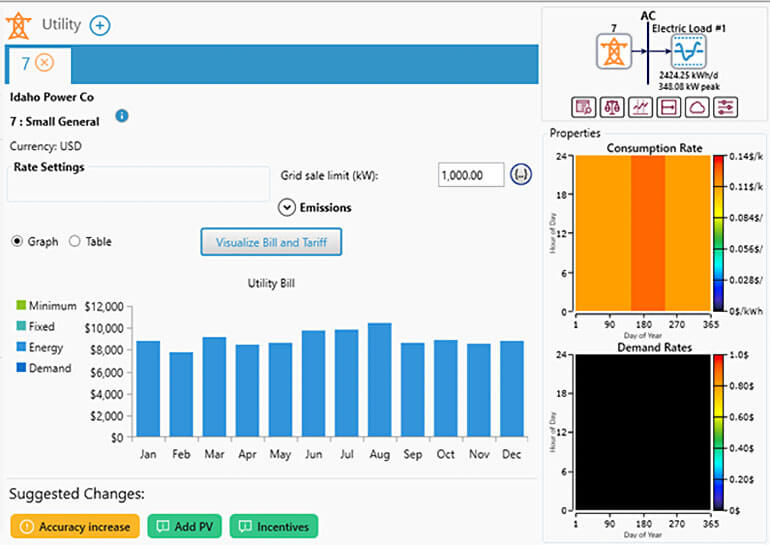
Source: HomerEnergy.com
The Future of Solar and Energy Storage
The development of solar power plants seems more imminent than never. Not only industrialised nations like the US or Germany are looking forward to investing in solar energy, but also nations from Latin America, Africa, and the Middle-East are looking forward to optimising their energy security by selecting an eco-friendly and free power source.
As solar power plants spread across the world, new reliability and stability issues will appear in the grid in multiple markets. This will increase the demand for energy storage to be able to continue adding renewable energy resources to the power grid of the nation.
It is believed that solar and wind energy cannot power an entire nation on their own due to their variability, however, when combined with energy storage, this becomes possible. Be among the first that will innovate in this market by considering energy storage and valuable simulation software for your projects.

















